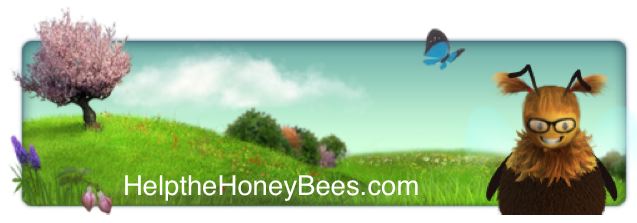What's Happening To The Honeybees?
Honeybees do a lot more than make honey! For thousands of years, honeybees have been important for honey, yes, but mostly for the incredible job they do of pollinating flowers and crops. Without the honeybees, there would be no more flowers. . . no more crops. . . no more blossoms of any kind.
When you put that glowing golden honey on your toast, look at it closely and consider that a honeybee had to visit hundreds of thousands of blossoms to get that tablespoon of honey you’re going to eat. Think about the ingredients in your bread. Think about the milk you’re drinking; without honeybees, there would be nothing for the cow to eat, and then there would be no milk, no hamburgers, no ice cream, and no cheese.
Without honeybees, there would soon be very little for people to eat. Think about that! Think very hard, because the collapse of honeybee colonies is a phenomenon that has recently been occurring all over the world at an alarmingly increasing rate, and nobody knows why.
What can you do about this? For starters, you can plant some of the flowers that honeybees love; this might attract the honeybees to your yard! Honeybees love sunflowers, violets, jasmine, lavender, coreopsis, trumpet flowers, cosmos, coneflowers, and thyme. All of these flowers smell wonderful! When the honeybees come to feast on the pollen, leave them alone. Don’t chase them, or step on them. Just watch them do their job, buzzing from flower to flower, and listen to them hum as they work!
If you go to the Haagen-Dazs website, you can learn more about the honeybees.
What do honeybees actually do all day? We have exclusive, hidden video showing their secret activity. Okay… I’m lying. It’s just a video of a guy with bees, but it’s pretty darn interesting.





Dear Steve, Last year I went to Uganda to plant 100 Gardens for FAITH GARDEN PROJECT/Rotary International. We won the WORLD COMMUNITY SERVICE AWARD and are being featured at the United Nations on Nov 8th.
I am in the middle of planning next year’s gardening project in Bungoma, Kenya. I need to have your advice on flowers, plants and trees that honeybees love. Getting seeds into Kenya will be tricky, so I need a head start. We really need an experienced beekeeper to go with us. Any ideas?
Marilyn Uhl
International Project coordinator
Mountain City Rotary Club-TN
Marilyn – Congrats on the community service award! I wish that I had advice for you on flowers and plants that honeybees love, but I don’t. A few minutes on Google is bound to turn up more than I know. Sorry for the lack of info.
Honey bees have to go through a long process to make honey. The house bee and the field bee are involved in the process. First the field bee goes out and collects nectar, which it stores in an internal honey sac. They bring it back to the hive and transfer it to the house bee tongue to tongue. Then the house bee spreads a drop of nectar on the roof of a cell in a comb. During the next couple of days other house bees fan their wings over the nectar so that the moisture evaporates (nectar is 80% water and honey is 19% water). Finally, more house bees cover every cell filled with modified nectar with a thin layer of wax.
Thanks